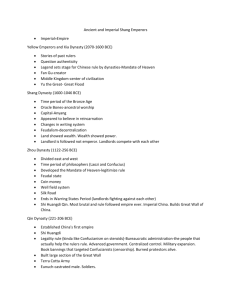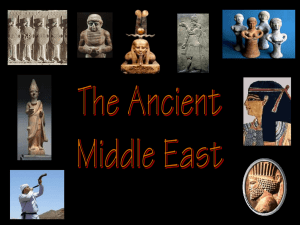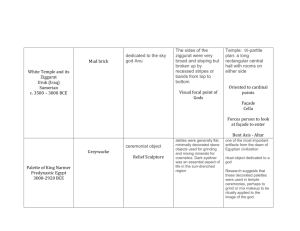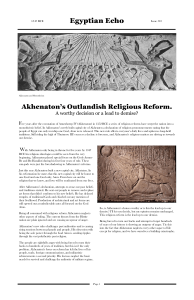AP ART HISTORY: SHMERYKOWSKY EGYPTIAN ART (SCULPTURE)
advertisement
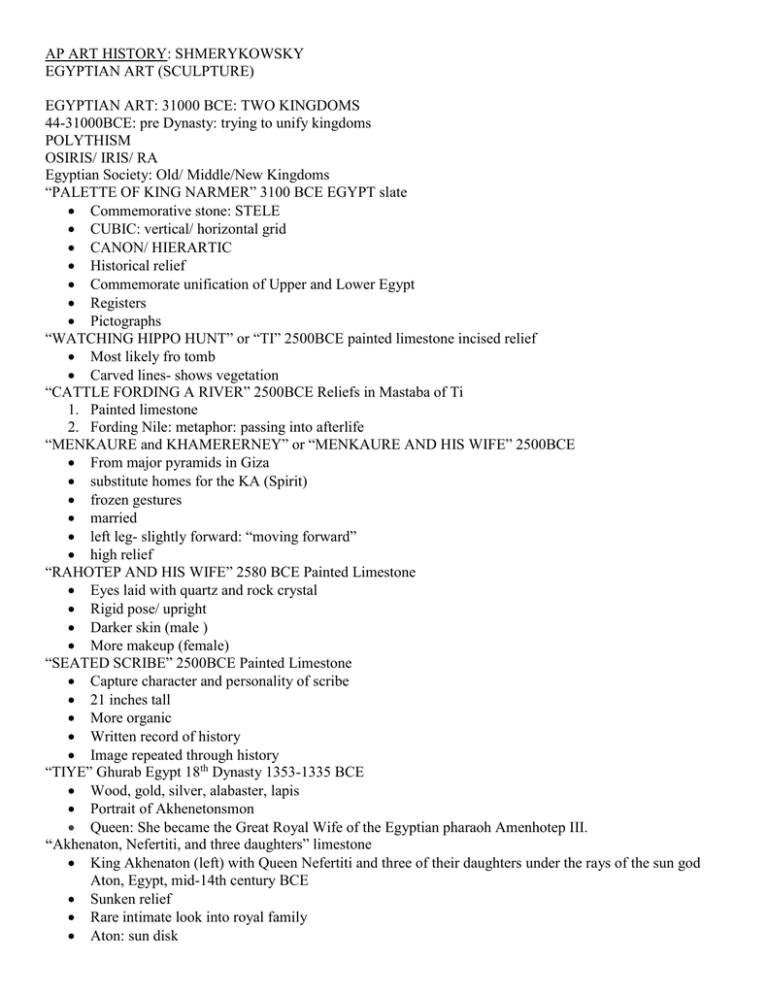
AP ART HISTORY: SHMERYKOWSKY EGYPTIAN ART (SCULPTURE) EGYPTIAN ART: 31000 BCE: TWO KINGDOMS 44-31000BCE: pre Dynasty: trying to unify kingdoms POLYTHISM OSIRIS/ IRIS/ RA Egyptian Society: Old/ Middle/New Kingdoms “PALETTE OF KING NARMER” 3100 BCE EGYPT slate Commemorative stone: STELE CUBIC: vertical/ horizontal grid CANON/ HIERARTIC Historical relief Commemorate unification of Upper and Lower Egypt Registers Pictographs “WATCHING HIPPO HUNT” or “TI” 2500BCE painted limestone incised relief Most likely fro tomb Carved lines- shows vegetation “CATTLE FORDING A RIVER” 2500BCE Reliefs in Mastaba of Ti 1. Painted limestone 2. Fording Nile: metaphor: passing into afterlife “MENKAURE and KHAMERERNEY” or “MENKAURE AND HIS WIFE” 2500BCE From major pyramids in Giza substitute homes for the KA (Spirit) frozen gestures married left leg- slightly forward: “moving forward” high relief “RAHOTEP AND HIS WIFE” 2580 BCE Painted Limestone Eyes laid with quartz and rock crystal Rigid pose/ upright Darker skin (male ) More makeup (female) “SEATED SCRIBE” 2500BCE Painted Limestone Capture character and personality of scribe 21 inches tall More organic Written record of history Image repeated through history “TIYE” Ghurab Egypt 18th Dynasty 1353-1335 BCE Wood, gold, silver, alabaster, lapis Portrait of Akhenetonsmon Queen: She became the Great Royal Wife of the Egyptian pharaoh Amenhotep III. “Akhenaton, Nefertiti, and three daughters” limestone King Akhenaton (left) with Queen Nefertiti and three of their daughters under the rays of the sun god Aton, Egypt, mid-14th century BCE Sunken relief Rare intimate look into royal family Aton: sun disk “NEFIRTITI: From AMAMA 18th Dynasty (1335-1335 BCE) Painted Limestone 28 inches high Akhenaton’s influential wife Long delicate curved neck “Beautiful one has come” Geometric but natural New Kingdom “DEATH MASK OF KING TUTUKAMEN” 18th Dynasty (1323BCE) From inner most part of tomb Semi-precious stones Treasures: wealth of Egyptian pharaohs A lavish afterlife Mummy encased in 3 nested coffins Innermost gold portrayal of pharaohs as Osiris Inner most is a fitting form Tomb in Valley of the Kings Sarcophagus Wide eyes/ translucent Crook and frail Tomb opened in 1920s -
